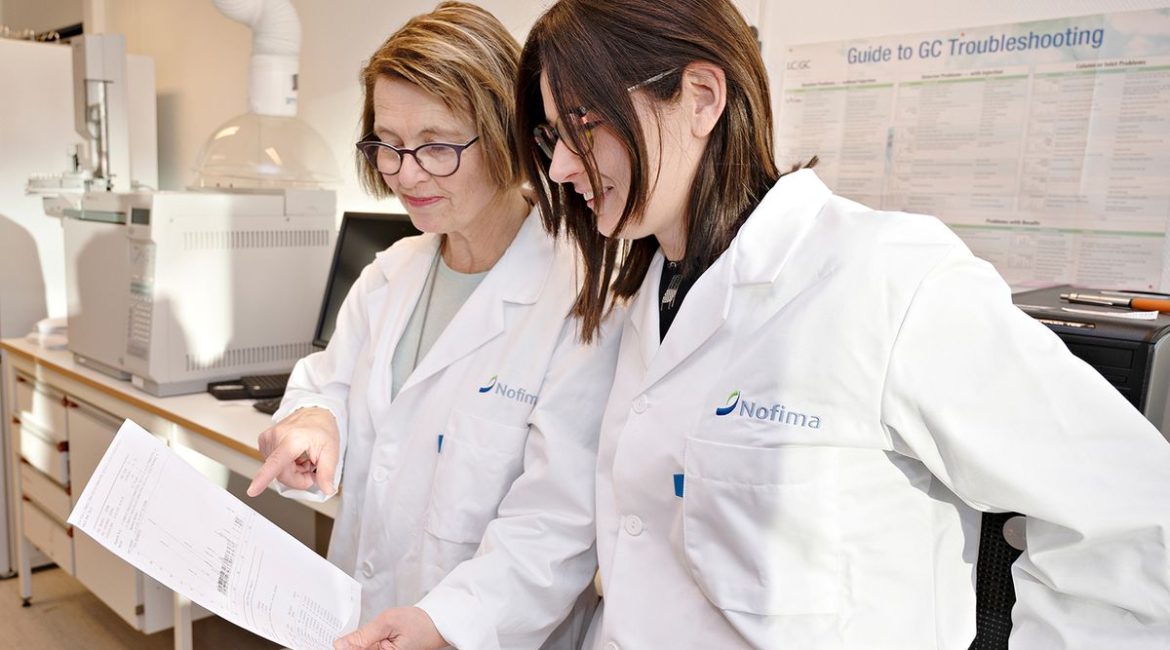In collaboration with Hofseth Aqua, Cargill is currently carrying out a comprehensive research project on trout to ensure feed that provides more robust fish and and improves health and welfare. Now they have received six million NOK/about 600.000 EURO funding from the Norwegian Research Council, with the research institution Nofima joining the team.
Photo above: Researcher Marta Bou Mira, Nofima, in lab. Photo by Jon-Are Berg-Jacobsen/Nofima.
The funding will support a project where fish are fed diets that contain different amounts of the omega-3 fatty acids EPA and DHA.
Previous research on salmon has shown that higher levels of marine omega-3 fatty acids can be beneficial when salmon are sick or stressed, but not as much is known about trout. These fatty acids are in turn substances that the human body needs. They can reduce the risk of cardiovascular disease and contribute to good brain function and development and visual functions.
Close cooperation
Hofseth and Cargill already have a well-established collaboration to test various nutritional strategies in full scale that will make trout more robust.

“What we are going to do now is a spin-off project where we go deeper into the knowledge. We want to better understand the mechanisms of action. What happens in the cells and genes of the fish when we increase the proportion of EPA and DHA,” says Terje Utne who is responsible for field trials in Cargill Aqua Nutrition North Sea.
As only five percent of Norwegian aquaculture is trout farming, most of the research is done on salmon. This project is therefore groundbreaking, and it is also unique because it takes place in the field where two different diets are tested simultaneously in many cages.
Trout and salmon
Hofseth Aqua provides no less than 16 cages for this trial at three locations in Storfjorden where trout are produced in a large scale.
The company, which is located mid-Norway, has a very positive attitude towards research during ongoing commercial production, even though it is labor-intensive. The employees see the benefit of how important it is to improve fish welfare.
The support from the Research Council also makes it possible to carry out a lab trial to investigate the differences between salmon and trout that receive different amounts of EPA and DHA.
“This has not been done before either. It will be interesting to compare the results from two different species,” says Utne.
He emphasizes that EPA and DHA are costly and limited resources, but at the same time very important for both the fish and us humans. Better knowledge gives us the opportunity to utilize EPA and DHA in a better and more sustainable way.
Researching the omega-3 mechanisms
In this trial, Nofima will have access to sample materials from the field in a unique extent, and they will run their own trials on trout and salmon in tanks at their research station.
Researchers at Nofima have recently found that rainbow trout have a greater capacity to store EPA and DHA in the body than salmon.
“This indicates that salmon and trout may have different requirements and capacity to convert and utilize sources of marine omega-3 fatty acids. We are very interested in investigating the mechanisms behind these differences. Then we can better understand the needs for marine omega-3 fatty acids in trout and develop strategies to make the best possible use of resources,” says Marta Bou Mira, researcher at Nofima.
The project will be completed in early 2023, and the results will be reported in the fourth quarter of 2024.
Du finner denne artikkelen også på Kyst.no

Researcher Marta Bou Mira at Nofima, in picture holding salmon filet. Photo: Joe Urrutia/Nofima
